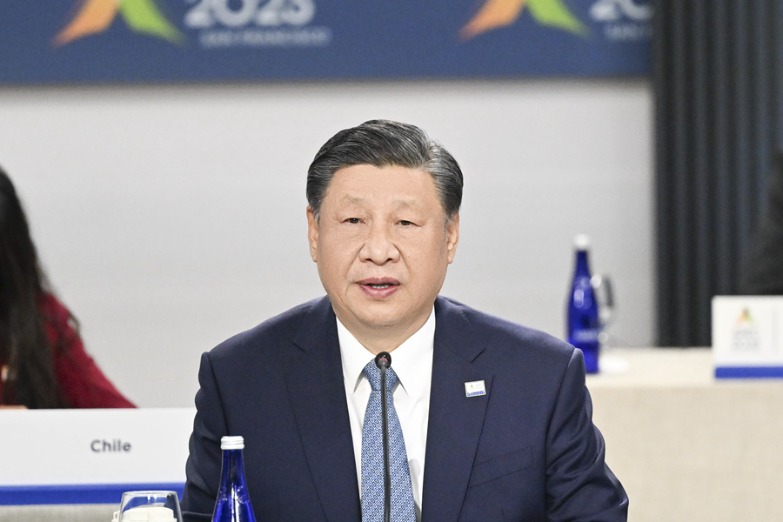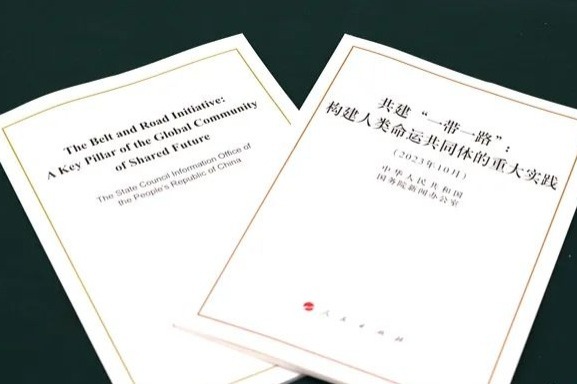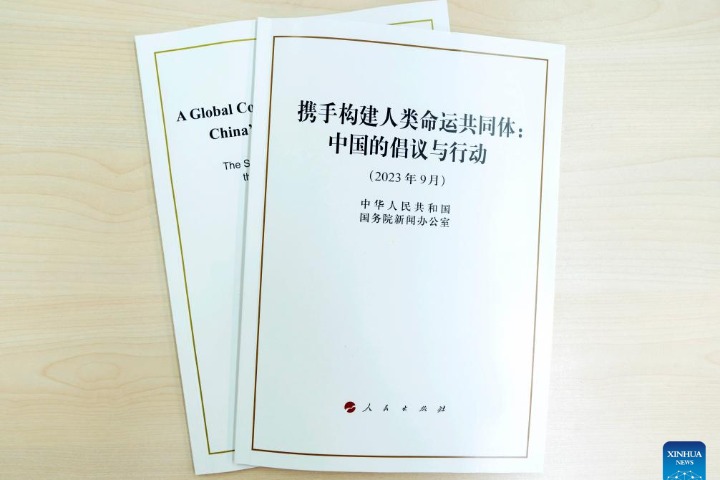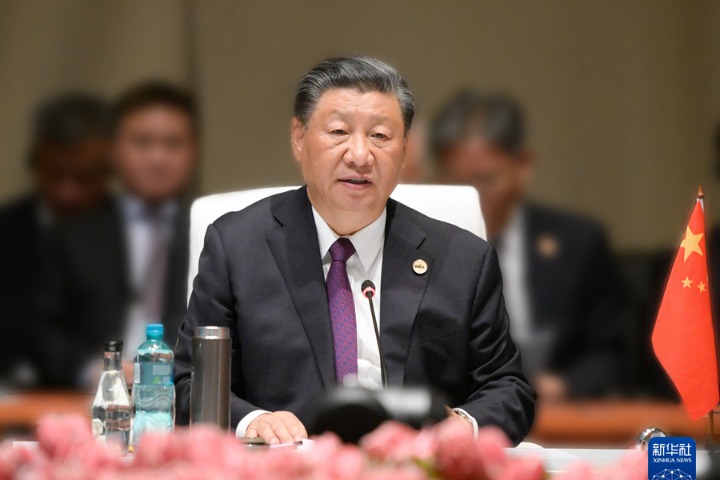《中国的粮食安全》白皮书(双语全文)
新华网 2019-10-15 13:55

四、未来展望与政策主张
IV. Prospects and Policies
当前,中国粮食连年丰收、库存充裕、供应充足、市场稳定,粮食安全形势持续向好。展望未来,中国有条件、有能力、有信心依靠自身力量筑牢国家粮食安全防线。国家粮食安全保障政策体系基本成型,全面实施国家粮食安全战略,依靠自己保口粮,集中国内资源保重点,使粮食之基更牢靠、发展之基更深厚、社会之基更稳定。农业供给侧结构性改革尚有很大空间,粮食科技进步、单产提高、减少损失浪费、利用非粮食食物等方面还有较大潜力可供挖掘。充足的粮食储备可以保障粮食市场供应和市场基本稳定,现代化的粮食仓储物流体系可以防止出现区域性阶段性粮食供给紧张问题,市场机制充分发挥作用能够解决品种结构矛盾。
China has recently enjoyed a run of good harvests. There are adequate grain supplies and reserves, and a stable grain market, which are indicators of increasing food security. Looking to the future, China has the conditions, capabilities and confidence to enhance food security relying on its own efforts. A national system of food security guarantee policies is in place. China's food strategy in the new era consists of ensuring security of food through food self-sufficiency, pooling domestic resources to ensure key links in food security, and securing food supply as a foundation for national development and social stability. There is plenty of space for supply-side structural reform in China's agriculture industry; there is plenty of room for progress in China's agro-technology, in terms of increasing per unit area yield, reducing food waste, and developing non-grain foods. Adequate grain reserves help ensure market supply and a basically stable market; a modernized grain storage and logistics system helps prevent regional or provisional food supply crises; market mechanisms in full play help improve the structure of grain varieties.
从中长期看,中国的粮食产需仍将维持紧平衡态势,确保国家粮食安全这根弦一刻也不能放松。从需求形势看,随着经济社会发展,人均口粮消费将稳中略降,饲料和工业转化用粮消费继续增加,粮食消费总量刚性增长,粮食消费结构不断升级。从生产形势看,农业生产成本仍在攀升,资源环境承载能力趋紧,农业基础设施相对薄弱,抗灾减灾能力有待提升,在确保绿色发展和资源永续利用的同时,稳定发展粮食生产压力较大。从流通形势看,粮食生产将继续向核心产区集中,跨区域粮食流通量将进一步增加,粮食市场大幅波动的风险依然存在。
In the medium to long term, China's grain production and demand will remain closely aligned, which means China must not slacken its efforts to ensure food security. Per capita grain consumption and demand will drop slightly with social and economic development; the consumption of grain as feed for livestock and grain used for industrial purposes will continue to rise; total grain consumption will increase and pursue higher quality. In terms of grain production, agricultural costs are still rising, and resource and environmental carrying capacity (RECC) is broaching its limit. Agricultural infrastructure is comparatively weak, and capacity for disaster prevention and relief must be improved. China will find itself under considerable pressure to maintain steady grain production while ensuring green development and sustainable resource use. In terms of grain circulation, grain production will continue to be concentrated in core production areas. Transregional grain flows will increase, and there is still the risk of dramatic fluctuations in the grain market.
展望世界粮食安全形势,国际粮农机构全球粮食安全治理效果逐步显现,各国促进国际粮食市场有序流通、维护世界粮食市场总体稳定的愿望增强,贫困缺粮国家粮食生产得到发展,能够减轻国际市场波动对国内市场带来的不利影响,为中国和世界粮食安全营造良好环境。与此同时,当今世界粮食安全挑战依然严峻,仍有8亿多饥饿人口,国际粮食贸易面临着保护主义和单边主义的干扰,不稳定因素增加,实现相关可持续发展目标任重道远。
In global terms, international institutions for food and agriculture have achieved outcomes in improving global food security governance. All countries have an increasing will to facilitate orderly circulation in the international food market and overall stability. Progress has been made in grain production in low-income food-deficit countries, which will mitigate the negative impact of international market fluctuations upon domestic markets, and create a sound environment for China's and for global food security.At the same time, today's world is still facing severe food security challenges. There are still over 800 million people suffering from hunger, while international food trade is being disrupted by protectionism and unilateralism, and showing increasing instability. These challenges mean that the world has a long way to go in reaching its sustainable development goals.
立足国内,放眼全球,中国将继续坚定不移地走中国特色粮食安全之路,全面贯彻新发展理念,全面实施国家粮食安全战略和乡村振兴战略,全面落实“藏粮于地、藏粮于技”战略,推动从粮食生产大国向粮食产业强国迈进,把饭碗牢牢端在自己手上,在确保国家粮食安全的同时,与世界各国携手应对全球饥饿问题,继续在南南合作框架下为其他发展中国家提供力所能及的帮助,共同推进全球粮食事业健康发展。
In view of domestic and global food security, China will forge ahead along its own path. Pursuing a new development philosophy, China will implement its national strategies for food security and rural vitalization through sustainable farmland use and agricultural technology innovation to increase farmland productivity. China will advance from a large grain producer to a food industry power, holding firm its "rice bowl". While ensuring domestic food security, China will join the global fight against hunger. China will continue to provide assistance to the best of its ability to other developing countries within the framework of South-South cooperation, and promote the sound development of the global food industry.
(一)提高粮食生产能力
1. Enhancing food productivity
——坚守耕地保护红线,节约和高效利用水资源。到2020年,落实12436万公顷耕地保有量、10307万公顷永久基本农田、4072万公顷建设用地总规模约束性指标,确保建成5333万公顷高标准农田,全面完成粮食生产功能区和重要农产品生产保护区建设,粮食种植面积稳定在1.1亿公顷以上,粮食综合生产能力稳定在6亿吨以上。不断提高耕地质量,到2022年,确保建成6667万公顷高标准农田。到2035年,粮食种植面积保持总体稳定。加快推进节水供水重大水利工程建设,不断完善农田水利设施,提高水资源利用效率。
- Keeping to the red line for the protection of cultivated land and saving and utilizing water resources efficiently. By 2020, China will implement the following mandatory indexes and achieve the following targets:
-124 million ha of cultivated land,
-103 million ha of permanent basic farmland,
-no more than 40.7 million ha of land for construction,
-53.3 million ha of high-standard farmland,
-complete functional areas for grain production and protected areas for the production of important agricultural products,
-maintain a grain planting area of above 110 million ha, and
-maintain a comprehensive grain production capacity of above 600 million tons.
China will continue to improve farmland quality. By 2022, it will complete the construction of 66.67 million ha of high-standard farmland, and by 2035, it will keep its grain planting area generally steady. It will implement major hydro construction projects for water conservation and supply, improve farmland hydro facilities, and increase water resource utilization efficiency.
——推进种植结构调整,增加绿色优质粮油产品供给。稳定谷物种植面积,因地制宜发展薯类、豆类、杂粮等作物。大力发展强筋弱筋小麦、优质稻谷、青贮及专用玉米、高油高蛋白大豆等,通过优质优价促进农民增收。继续实施优质粮食工程和“中国好粮油”行动计划,服务绿色农业发展和“健康中国”建设,大力增加绿色优质粮油产品供给。
- Adjusting the crop planting structure and increasing the supply of green and high-quality grain and edible oil. China will keep its grain planting area steady, and develop tuber crops, legume crops, and miscellaneous grain crops in accordance with local conditions. Crop varieties will include strong gluten wheat, weak gluten wheat, high-quality rice, silage corn, special corn, and high-oleic and high-protein soybean. Farmers' incomes will increase by selling high-quality produce at higher prices. China will continue implementing the Quality Food Project and the Healthy Grain and Edible Oil Action Plan, facilitate green agricultural development and the Healthy China initiative, and increase the supply of green and high-quality grain and edible oil.
——创新体制机制,提高粮食生产组织化程度。推动农村承包土地所有权、承包权、经营权“三权分置”有序实施,培育新型经营主体和服务主体,发展土地流转型和服务引领型规模经营,促进小规模、分散经营向适度规模、主体多元转变。加强新型职业农民培训,支持农民通过股份制、股份合作制等多种形式参与规模化、产业化经营。完善针对小农户的扶持政策,把小农户引入现代农业发展轨道。
- Upgrading institutions and mechanisms for better organized grain production. China will separate the ownership, contracting right and management right of rural contracted land in an orderly manner. It will foster new types of operating and service entities, promote moderate-scale management oriented by land transfer and service, and transform small-scale, decentralized management into moderate-scale, multi-entity management. A new generation of professional farmers will benefit from better technical training, who will be encouraged to participate in large-scale, industrialized management through shareholding and shareholding cooperative systems. China will improve policies to support small agricultural households, and help them adapt to modern agricultural development.
——增强农业科技创新能力,提高粮食生产水平。强化农业基础研究,全面升级节水灌溉、农机装备、农药研制、肥料开发、加工储运、循环农业等应用技术。强化种业科技创新,突破种质创新、新品种选育、高效繁育和加工流通等核心技术。强化技术集成创新,攻克影响作物单产提高、品质提升、效益增加、环境改善的技术瓶颈。推进农业机械化和农机装备产业转型升级,依靠科技手段和农艺农技应用,增加粮食供给,提升粮食品质。
- Enhancing agro-technological innovation and improving grain production capacity. China will promote basic agricultural research and upgrade technologies in water conservation and irritation, and focus on agricultural machinery, pesticide R&D, fertilizer development, the processing, storage and transport of grain, and circular agriculture. China will continue to innovate in the seed industry, making breakthroughs in core technologies such as germ plasm improvement, and the creation, efficient cultivation, processing, and circulation of new crop varieties. China will enhance integrated technological innovation, breaking logjams in improving per unit area yield, crop quality, economic benefits, and the environment. China will promote mechanization in agriculture and transform and upgrade the agricultural machinery industry, increasing grain supply and improving grain quality through the application of agronomy and agro-techniques.
(二)加强储备应急管理
2. Improving the management of emergency grain reserves
——加强粮食储备管理。以服务宏观调控、调节稳定市场、应对突发事件和提升国家安全能力为目标,科学确定粮食储备功能和规模,改革完善粮食储备管理体制,健全粮食储备运行机制,强化内控管理和外部监督,加快构建更高层次、更高质量、更有效率、更可持续的粮食安全保障体系。
- Improving the management of grain reserves. To facilitate macroregulation, a steady market, sound emergency response, and national security, China will apply scientific rationale in designing the functions and scale of grain reserves. It will reform and complete its management mechanisms, improve its operating mechanisms, and strengthen internal management and external supervision. The goal is to build a food security guarantee system which is more advanced, effective, efficient and sustainable.
——健全粮食应急保供体系。优化粮食应急供应、配送、加工网点的布局,建成一批规范化粮油配送中心、粮油应急加工企业和应急供应网点,形成布局合理、设施完备、运转高效、保障有力的粮食应急供应保障体系,强化应急处置功能,提升应急供应保障水平。
- Improving the emergency grain supply guarantee system. China will establish a network for the supply, delivery and processing of grain for emergency use. A number of standardized delivery centers, emergency processing enterprises, and emergency supply centers for grain and edible oil. China will form an emergency grain supply guarantee system with well-distributed shops and complete equipment that runs efficiently and provides solid support. China will enhance emergency response functions and guarantee emergency supplies.
——完善粮情预警监测体系。强化粮油市场预警机制,加快建立健全涵盖国家、省、市、县四级的监测预警体系,依托信息技术准确把握国内外粮食形势,健全粮油市场监测网络,提供及时、准确、全面的市场信息服务,防范市场异常波动风险。
- Improving the grain monitoring and pre-warning system. China will improve the pre-warning mechanisms for the grain and edible oil market by establishing a national monitoring and pre-warning system at the state, provincial, municipal and county levels. China will accurately follow domestic and international grain developments through IT application. China will improve the monitoring network for the grain and edible oil market, to provide timely, accurate and all-faceted market information services, and to guard against abnormal market fluctuations.
——倡导节粮减损。大力开展宣传教育活动,增强爱粮节粮意识,抑制不合理消费需求,减少“餐桌上的浪费”,形成科学消费、健康消费、文明消费的良好风尚。普及推广经济、适用、防虫、防霉储粮新装具、新技术,帮助农民减少产后损失。示范推广绿色、环保、智能粮食储藏设施设备,鼓励适度加工,提高物流效率,减少粮食流通环节的损失损耗。
- Encouraging grain conservation and reducing losses. China will launch publicity and education activities to enhance public awareness of food conservation, contain unnecessary consumption, reduce food waste, and to foster rational, healthy and civilized consumption. China will popularize new equipment and technologies for grain storage that are economical, effective, insect-resistant and mildew-proof, to reduce farmers' postproduction losses. China will popularize green, eco-friendly and smart equipment and facilities for grain storage, encourage moderate processing, raise logistics efficiency, and reduce circulation losses and spoilage.
(三)建设现代粮食流通体系
3. Building a modern grain circulation system
——加快建设现代粮食市场体系。坚持市场化改革取向与保护农民利益并重,以确保口粮绝对安全、防止“谷贱伤农”为底线,适应世界贸易组织规则,积极稳妥推进粮食收储制度和价格形成机制改革,充分发挥市场配置粮食资源的决定性作用,更好发挥政府作用,使粮价更好地反映市场供求,激发市场活力,促进供需平衡,加快形成统一开放、竞争有序的现代粮食市场体系。
- Stepping up efforts to build a modern grain market system. China places equal importance on market-oriented reform and protecting farmers' interests. Upholding its red line of absolute security of staple food and zero risk to farmers from low grain prices, China will adapt itself to the WTO rules, actively and steadily reform its grain purchase and storage systems and pricing mechanisms, giving full play to the decisive role of market in allocating grain resources, and letting the government play its role better. Through these measures, China hopes that grain prices can better reflect market demand and supply, that market vitality will be boosted, and a balance between demand and supply can be achieved, to form a unified and open modern grain market system with orderly competition.
——切实加强粮食仓储物流建设。围绕优化布局、调整结构、提升功能,鼓励合理改建、扩建和新建粮食仓储物流设施,持续推进粮库智能化升级,增强安全运行保障能力。优化大型粮食物流园区布局,构建一批粮食进出口物流通道和重要节点,提升粮食物流重点线路流通效率。
- Improving grain storage and logistics. Focusing on improving distribution, structure and functions, China will encourage rational reconstruction, expansion and construction of grain storage and logistics facilities, to advance the smart management of grain depots and guarantee their safe operation. China will improve the distribution of large grain logistics parks, and build logistics passageways and major junctions for grain imports and exports, to increase efficient circulation on major grain logistics routes.
——着力构建现代化粮食产业体系。坚持高质量发展要求,倡导推广粮食循环经济模式。发展粮食精深加工与转化,大力推进主食产业化,不断增加绿色优质和特色粮油产品供给。着力推动优粮优产、优粮优购、优粮优储、优粮优加、优粮优销,加快构建现代化粮食产业体系。
- Building a modernized grain industry system. Pursuing high-quality development, China encourages a circular food economy. China will develop deep and intensive processing and conversion of grain, industrialize the processing of staple food, and increase the supply of green, high-quality and specialty grains and edible oils. China will boost the production of high-quality grain, purchase it at higher prices, and prioritize its storage, processing and sales. China will move faster to build a modernized grain industry system.
(四)积极维护世界粮食安全
4. Safeguarding global food security
——继续深入推进南南合作,为实现联合国2030年可持续发展目标中的“消除饥饿,实现粮食安全,改善营养状况和促进可持续农业”作出积极努力。
- Advancing South-South cooperation. China will work hard to achieve the goals set in the United Nations 2030 Agenda for Sustainable Development: "End hunger, achieve food security and improved nutrition and promote sustainable agriculture."
——深化与共建“一带一路”国家的粮食经贸合作关系,共同打造国际粮食合作新平台,促进沿线国家的农业资源要素有序自由流动、市场深度融合。
- Enhancing grain trade cooperation with the countries along the routes of the Belt and Road. Together, we will establish a new international platform for grain cooperation, to facilitate the free and orderly flow of agricultural resources and deep integration of markets in the Belt and Road countries.
——积极支持粮食企业“走出去”“引进来”,开展国际合作,合理利用国际国内两个市场、两种资源。优化粮食进口渠道,拓展多元化粮食来源市场,促进全球范围内粮食资源合理高效配置。
- Supporting Chinese grain enterprises in "going global" and "bringing in". China will make rational use of both domestic and international markets and resources. China will improve grain import channels, expand diversified food resource markets, and promote rational and efficient allocation of global grain resources.
——积极参与全球和区域粮食安全治理,积极探索国际粮食合作新模式,开展全方位、高水平粮食对外合作,维护世界贸易组织规则,促进形成更加安全、稳定、合理的国际粮食安全新局面,更好地维护世界粮食安全。
- Engaging in global and regional food security governance. China will explore new modes of international food cooperation, and conduct multifaceted and advanced cooperation with other countries. Observing WTO rules, China will do all it can to make international food security more secure, stable and rational in order to better safeguard food security of our world.
结束语
Conclusion
凡益之道,与时偕行。进入新时代,中国人民更加关注食物的营养与健康,既要“吃得饱”,更要“吃得好”“吃得放心”。初心不忘,人民至上。中国将在习近平新时代中国特色社会主义思想指引下,始终以人民对美好生活的向往为奋斗目标,牢固树立总体国家安全观,深入实施国家粮食安全战略和乡村振兴战略,进一步加强粮食生产能力、储备能力、流通能力建设,推动粮食产业高质量发展,提高国家粮食安全保障能力,为人民获得更多福祉奠定坚实根基。
There is an ancient Chinese teaching: All good principles should adapt to changing times to remain relevant. In the new era, the Chinese people are more concerned with their nutrition and health, from having enough food to eat to eating well and safely. The people's needs are the highest responsibility of the Chinese government. In line with Xi Jinping Thought on Socialism with Chinese Characteristics for a New Era, China will see that the people are able to realize their expectations for a better life. Pursuing a holistic approach to national security, China will further implement its national strategies for food security and rural vitalization. As a foundation for providing greater well-being for the people, China will increase food productivity, boost grain reserves, and improve grain circulation, to facilitate the high-quality development of its grain industries and strengthen the food security guarantee.
确保粮食安全,中国与世界命运休戚与共。中国将继续遵循开放包容、平等互利、合作共赢的原则,努力构建粮食对外开放新格局,与世界各国一道,加强合作,共同发展,为维护世界粮食安全作出不懈努力,为推动构建人类命运共同体作出新的贡献。
China has allied itself with the global effort to ensure food security. Under the principle of openness, inclusiveness, equality, mutual benefit, and win-win cooperation, China will be embracing a new situation of opening up with regard to food issues. In pursuit of common development, China is enhancing cooperation with all other countries to safeguard global food security, as a contribution to building a global community of shared future.

















 英语点津微信
英语点津微信 双语小程序
双语小程序